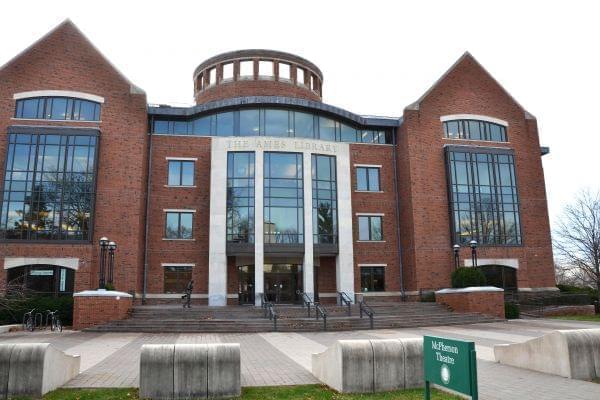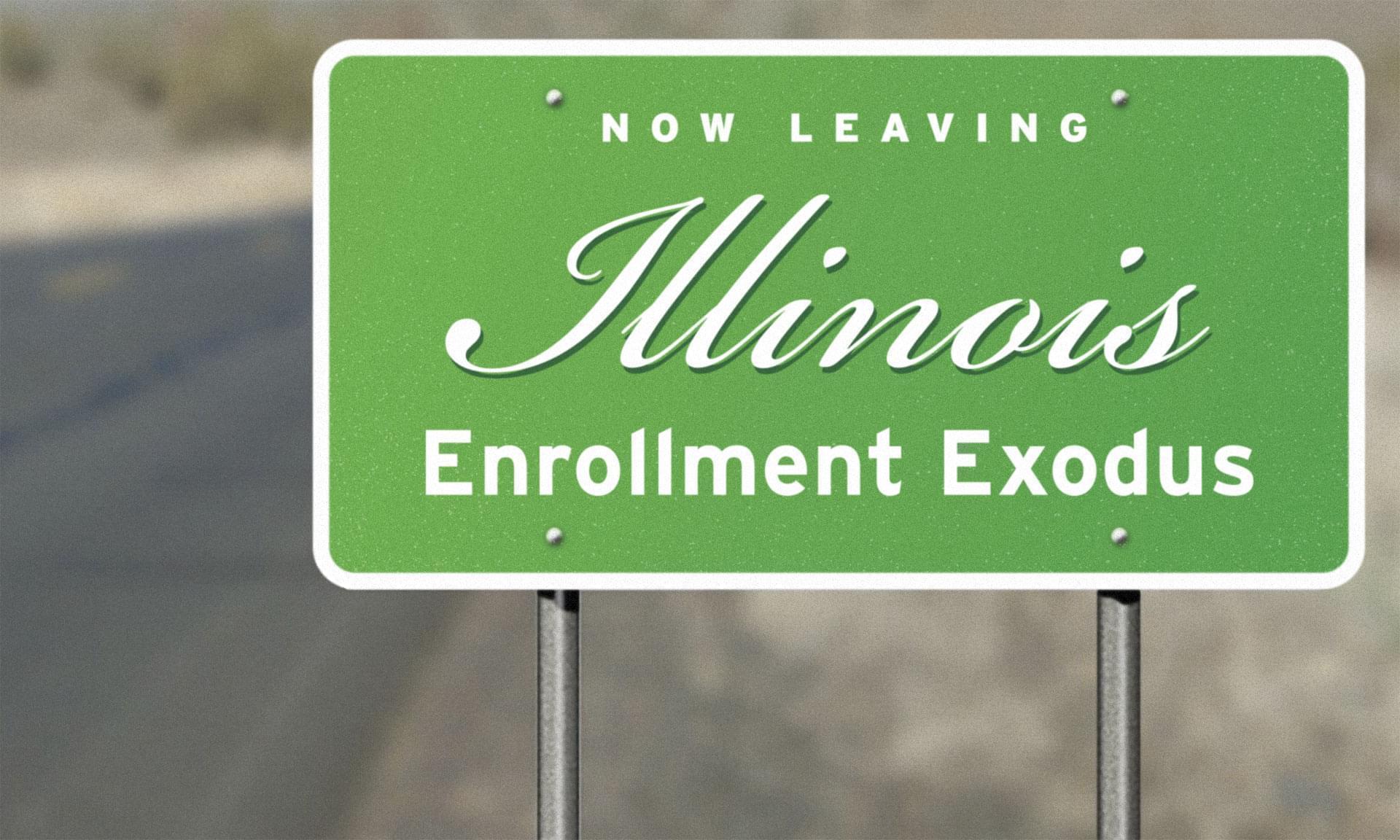Enrollment Exodus: How Private Colleges and Universities Are Meeting Enrollment Challenges

Ames Library at Illinois Wesleyan University. Staff/WGLT
Illinois colleges and universities have been under pressure for years from smaller graduating classes, out-of-state competition and changing demographics. Private higher education institutions in the state face the same challenges public schools do and a couple extra.
Private colleges and universities are competing for pieces of a smaller pie. The number of high school graduates in the state has fallen for years.
Justin Ball, vice president for enrollment management at Bradley University in Peoria, said based on WICHE data from the Western Interstate Commission on Higher Education, it will get worse.
“And then in 2026 you see it literally just fall off a cliff. I mean we’ll lose 8% to 9% of our entire high school graduating population over the course of one year,” said Ball.
Ball said the Great Recession had a big impact on family size, and there’s no rebound at least past 2033.
Colleges and universities in other states have also eaten Illinois’ lunch. Mac Ingmire is the dean of enrollment management at Eureka College in the Woodford County town of the same name.
“In 2006 36% of Illinois students who went to a four-year institution went out of state. In 2016, 10 years later, 48%. So, this number has been consistently on the rise,” said Ingmire.
Ingmire said there are multiple reasons for this, increased recruiting by out-of-state institutions, comparative underinvestment in need-based student aid by state government even before the state budget deadlock, and of course the uncertainty of any state aid in the Gov. Bruce Rauner years.
Every college and university in the state faces these pressures. But private colleges have other challenges.
PRICE PERCEPTION
Private colleges also have more challenges. The higher sticker price on a selective private institution can scare off the rising number of first generation and low-income high school graduates, according to Illinois Wesleyan University Dean of Admissions Greg King.
“Absolutely there is the possibility that the sticker price keeps families from engaging in the process. So, schools like us, all schools, we’re going to have to communicate differently. We’re going to have to get out in front of that cost conversation or we’re going to see applications dry up,” said King.
King said it helps that they can now put out parts of financial aid packages as early as November to help private schools stay in the conversation and let families know how competitive private schools such as IWU are.
Colleges are also reaching out earlier than ever. Many recruit as early as the sophomore year in high school, trying to craft relationships that will increase campus show rates.
Private colleges have also contended there’s a myth that public institutions are less expensive than private colleges and universities. Most of that has to do with sticker price because private schools have in-house scholarships to tack on to other forms of financial aid.
Bradley University’s Justin Ball said transparency moves under the Obama administration have helped. So have more educated high school guidance counselors that can help find schools with a good fit for their students, said Ball.
STEM vs. LIBERAL ARTS
Bradley, Eureka, and Illinois Wesleyan are private schools with a historic emphasis on the liberal arts. A generation into a national conversation about a lack of graduates in science, technology, engineering, and math or STEM, Greg King of Illinois Wesleyan said that approach is a tougher story to tell.
“More and more students are just learning about the liberal arts. The conversation about the liberal arts isn’t what it was 10, 15 years ago,” said King.
Some schools are deciding they cannot be all things any more. They are keeping programs in two or three strengths and ditching the rest. Justin Ball at Bradley University does not think that’s wise.
“When we have a young man or woman who comes here to be a mechanical or electrical engineer, we know that there is a really high probability that they will end up being involved in our music programs here, that they’ll be engaged in experiential learning, internships, study abroad programs,” said Ball.
In a kind of chicken-egg question, colleges must seek out high school graduating seniors who fit their institutions, but they also have to make sure they have the non-core programs that appeal to incoming students who sign up for a main specialty of the school.
Over at Illinois Wesleyan University, Greg King said schools which cut that deeply will know by 2030 or 2035 whether the gamble paid off.
This is not to say any institution is just standing pat. They are doing strategic assessments of efficiency, quality, and enrollment across areas of study. Since they have known for a decade the enrollment crunch was coming, you might think colleges and universities would have done this earlier. Justin Ball admitted most didn’t get on it.
“You know no one would ever say of colleges and universities … ’we’re really nimble’ (laughs),” said Ball.
FIRST-GENERATION STUDENTS
Private schools are tweaking how and where they recruit. When the number of first-generation students started trending upward a decade ago, Eureka College jumped on board with special mentoring and assistance programs. College President Jamel Wright said the school is now more than half first-gen—a higher proportion than most.
“And because of that now that first-generation program is a four year-program. So students have an opportunity to participate in first-generation programming for the entirety of their time at Eureka College,” said Wright.
Not all first-gen and low-income students are the same. Bradley University’s Justin Ball said first-generation students from one demographic group might be more, or less, likely to stay in school than first-generation students of another. Income levels also cloud the picture. Urban versus rural backgrounds also matter for first-generation college students. He said private institutions must carefully parse those data and develop retention programs that target specific cohort of kids. First-gen students tend to stay closer to family, and not go across the country, said Ball.
WHERE TO RECRUIT
Bradley University finds students from rural areas tend to have good outcomes in its engineering program. Justin Ball said Bradley recruits in small towns as a result.
“It does take more time and energy and it does take more boots on the ground,” said Ball.
Schools look for community ties to shape recruitment. Bradley focuses on cities with a strong presence of workers for Komatsu and Caterpillar, native to Peoria. Illinois Wesleyan recruits in sunbelt cities that have State Farm Insurance hubs. Ronald Reagan alma mater Eureka College finds Reagan organizations in California and Washington, D.C., important.
IWU has students from 40 states and recruiters in various regions. That’s similar to Bradley and Eureka. But Illinois Wesleyan Admissions Dean Greg King said most students come from Illinois.
“We have to take care of our back yard. 80% to 90% of enrollment is coming to you from within two hours,” said King.
Illinois Wesleyan has even offered a separate scholarship to entice high school graduates from McLean County to enroll. The case for such a scholarship is that students tend to settle in places where they go to college and then find jobs. The McLean County Scholarship, IWU hopes will keep graduates in town, raising families and paying dividends in 20 years when THEIR children go to college.
“We’ve seen some good results on the McLean County Scholarship. Annually we’d have about 25 students from McLean County, and last year it took us to 35,” said King.
ALLIANCES AND AGREEMENTS
Private colleges and universities, like their public counterparts, are building alliances and strategic agreements with community colleges to track students on to four-year institutions. And Eureka College President Jamel Wright said more is needed. She believes it is necessary to play nicer with like-sized private institutions.
“There may be programs that a pocket of our students might really desire. But maybe Millikin offers it. Or maybe Augustana offers that program. Well, Augustana or Millikin might be struggling to fill the seats in their courses,” said Wright.
Eureka has also focused on workforce development, traditionally the purview of community colleges.
“We are adding new pathways to degree completion or additional certification which we know is a huge call. We are looking at ways to better accommodate adult students. We know that is a growth population, said President Wright.
She said Eureka wants to attract students returning from the military or who have jobs and families and who need classes at different times of day.
Eureka has also reached out to Core Construction and the trades and labor unions.
“They said their pipeline for project managers and superintendents was dry. And we’ve created a series of workshops that they said they need for their folks in the field to move up in management and leadership roles,” said Wright.
INTERNATIONAL STUDENTS
Many public colleges and universities focus on drawing international students. Private institutions do less of that and when they do it tends to be for different reasons.
Justin Ball at Bradley said fewer international students pay full freight at privates than do so at the publics. The reason, he said, is because foreign students pay attention to global brand awareness and target public institutions of prestige.
So the incentive for private colleges and universities to discount tuition to international students is to address diversity needs and to fill seats that otherwise would not be filled, said Ball.
FINANCIAL AID
Last year, Illinois Wesleyan had a big bump up in enrollment connected to an increase in financial aid paid for with a drawdown on endowment money. Some faculty have flatly said the school went out and bought a larger freshman class.
“Well yeah, in 2018 there were some things that were important to us. We wanted every bed on campus filled and we did that. We wanted to increase our diversity and we did that. A full third of our incoming class was a student of color,” said Greg King.
And he said a high retention rate even compared to selective admission peer institutions suggested the bet was a good one.
This year, IWU’s entering class was smaller. But King said it’s not like Illinois Wesleyan is alone in using endowment money for aid.
“When you are looking at competition and other schools fighting to grow or preserve their enrollment, the best way to do that is with a competitive financial aid package,” said King.
Can small private schools like Bradley and IWU maintain their selective admission standards in the face of lower high school populations?
“Absolutely, selectivity is very possible and families when they see the success and the academic strength, they are willing to pay $1,000, $2,000 more for a place like Illinois Wesleyan to get an outcome that is proven,” said King. “Yeah, when you look at those trends, they’re disturbing. But, we’re well-aware of those and who we need to be and how we need to tell our story.”
Private colleges and universities are emphasizing outcomes, employability, the jobs kids find, the income of graduates five and 10 years out, and so on. Return on investment is a big phrase.
With at least 14 more years of declines in the number of high school graduates projected, Admissions officers nationwide acknowledge some schools won’t make it.
Which ones will fail?
“The institutions that can’t control their costs. The institutions that don’t have a distinctive story to tell. The institutions that don’t stand out on the outcome side,” said King.
This story is part of the weeklong Enrollment Exodus series, produced by public radio stations across the state, about challenges facing higher education in Illinois.

Links
- Enrollment Exodus: Why So Many Chinese Students Choose That ‘Cornfield’ School In Illinois
- Enrollment Exodus: Public Universities Do More Than Educate Students
- Surge In Vaping-Related Illness; Illinois College Enrollment Numbers; Why Doesn’t IL Have NCAA Division-I Hockey?
- U Of I Urbana Fall Enrollment Breaks Past 50,000

